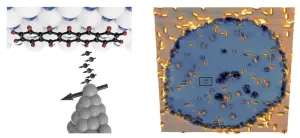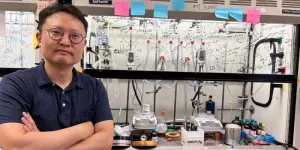Published in Science, Science Immunology, and Science Translation Medicine on May 16, 2024, the findings are outlined in four individual papers and build on a 2022 phase I clinical trial conducted by the nonprofit scientific research organization IAVI. The findings represent a key step forward in an immunization strategy that could protect against the virus.
“All in all, these studies show that we have a good chance at creating an effective HIV vaccine—we just need to keep iterating and build on these findings in future clinical trials,” says co-senior author of all four studies, William Schief, PhD, who is also a Scripps Research professor; vice president for antigen design and selection, Infectious Disease Research, at Moderna, Inc.; and executive director of vaccine design at IAVI's Neutralizing Antibody Center.
The HIV vaccine strategy involves stimulating the body to produce mature broadly neutralizing antibodies (bnAbs). bnAbs are among the immune system’s key players in fighting HIV, since they can block many variants of the virus. The problem is that bnAbs produced by the human body are rare. The IAVI trial, spearheaded in part by Schief, focused on inducing the immune cells that could eventually evolve into the right bnAbs—ones that could protect host cells from multiple HIV strains. These precursor immune cells, known as B cells, were stimulated with the help of a priming immunogen—a customized molecule to “prime” the immune system and elicit responses from the correct precursor cells.
But the primer also requires additional “booster” immunogens to coax the immune system into producing not just precursor cells, but coveted VRC01-class bnAbs—a rare and specific class of antibodies known to neutralize more than 90 percent of diverse HIV strains. Boosters are also needed for the production of BG18—another important bnAb class that binds to sugars on the HIV spike protein. That’s where the new studies come in: Researchers developed immunization regimens that could prime either VRC01 or BG18 precursors, and subsequently boost those precursors further down the path toward becoming bnAbs.
“The results contained in these papers are deeply exciting and further support the germline-targeting strategy to HIV vaccine development that IAVI and our partners are pursuing,” says Mark Feinberg, MD, PhD, president and CEO of IAVI. “We look forward to continuing our collaboration with Scripps Research and partners to advance further research building on these promising findings.”
This groundbreaking science is enabled by collaboration between scientific institutions and funding partners. Without the ongoing, critical support of the Scripps Consortium for HIV/AIDS Vaccine Development (CHAVD), the Collaboration for AIDS Vaccine Discovery (CAVD), the Bill & Melinda Gates Foundation, and Moderna (the manufacturer of the mRNA used in these studies), this research would not have been possible.
Priming rare antibodies
In the first study, which focused on BG18, Scripps Research scientists collaborated with co-senior authors Shane Crotty, PhD, chief scientific officer at La Jolla Institute for Immunology, and Devin Sok, PhD, former vice president, discovery and innovation at IAVI. Using a priming immunogen, they consistently primed exceptionally rare BG18 precursors in a wild-type animal model.
To confirm they were able to prime the correct precursors, the researchers then teamed up with Andrew Ward, PhD, Scripps Research integrative structural and computational biology professor and co-senior author of the study. Using cryo-EM structural analysis, they validated that the antibodies were indeed part of the BG18 class.
“The fact that priming worked well in macaques suggests that it has a good chance of succeeding in humans,” says co-first author, Jon Steichen, PhD, an institute investigator in the Department of Immunology and Microbiology at Scripps Research.
Steichen was also co-first author on a second study, in which mice were modified to produce a low frequency of BG18 precursors. Scripps Research and IAVI scientists, along with the team of co-senior author Facundo Batista, PhD, associate director and scientific director of the Ragon Institute of MGH, MIT, and Harvard, used priming methods similar to the ones used in the first paper. However, a key difference was that this time, they also administered one of two boost immunogens using RNA technology. This resulted in boosting the primed B cells to adapt to recognize more native-like versions of HIV.
“This study showed that we can start to walk the B cells along toward bnAb development,” Steichen explains.
Supercharging the immune system into action
For the third study, Schief and his team worked with IAVI scientists, wherein they primed a mouse model with the same immunogen used in the 2022 IAVI clinical trial. This resulted in mice that produced VRC01-class precursor B cells similar to those found in people. But the researchers also designed a new booster immunogen to drive the antibody response toward becoming matured bnAbs—the next vital step in a sequential immunization series that could effectively fight HIV. The results: a “prime-boost” regimen that can drive VRC01-class B cells toward bnAb development.
“The findings demonstrate that we are able to make the antibody responses go in the right direction using this heterologous booster, which administers a different version of the vaccine than was given previously,” says Christopher Cottrell, PhD, a senior staff scientist at Scripps Research who was the first co-author on this study.
Understanding the immunology
In the fourth and final study, on which Cottrell was also a co-first author, the team worked again with Batista’s team at the Ragon Institute and used the same immunogens—but in a different mouse model where his team could control the frequency of bnAb precursors that were modified to be similar to those found in humans. This allowed the researchers to take a deeper dive into the immunology associated with HIV vaccination by examining the germinal centers—specialized microstructures in the body that protect against viral reinfection. Germinal centers provide B cells with a space to rapidly increase and mutate their antibody genes, ultimately helping the immune system fight off viral strains.
In addition, the researchers examined how germinal centers accumulate HIV mutations over time. They found that a prime-boost regimen increased precursor B-cell activity in germinal centers across different lineages, which could eventually lead to an increase in matured VRC01-class bnAbs.
What’s next
Overall, all four papers confirm that the priming step to turn on the right bnAb precursors is possible when it comes to developing an HIV vaccine. Three of those papers specifically demonstrate that it’s also possible to guide antibody precursors toward becoming bnAbs that can fight HIV.
“Taken together, the findings give us more confidence that we're able to prime precursors from multiple bnAb targets, and they also show that we're starting to learn the rules for how to advance precursor maturation through heterologous boosting,” Schief added.
Following these results, the researchers are advancing phase 1, experimental medicine trials for both the VRC01 and BG18 projects. Vaccines aiming to prime and boost VRC01-class antibodies are being further evaluated in two clinical trials run by IAVI, IAVI G002 and IAVI G003, and a vaccine to prime BG18-class responses is being evaluated in HVTN144. These studies use both adjuvanted protein immunizations (IAVI G001 and HVTN144) and mRNA delivery (IAVI G002 and G003).
The results of these studies will guide the critical next steps on the discovery path to an HIV vaccine.
//
This work and the researchers involved were supported by funding from the National Institutes of Health (grant U24GM129547); the National Institute of Allergy and Infectious Diseases (grants UM1 Al100663, UM1 AI144462, R01 AI113867, and R24 AI162317); the Bill & Melinda Gates Foundation Collaboration for AIDS Vaccine Discovery (grants NAC INV-007522/ OPP1084519, INV-021989, INV-034657, INV-009585, INV-046626, OPP1147787/INV-007385, OPP1196345/INV-008813, OPP1115782/INV-008556, and INV-002916); IAVI; and the Ragon Institute of Mass General, MIT, and Harvard.
In addition to Schief and Steichen, the authors of the study, “Vaccine priming of rare HIV broadly neutralizing antibody precursors in nonhuman primates” are Gabriel Ozorowski, Sabyasachi Baboo, Christopher A. Cottrell, Jonathan L. Torres, Krystal M. Ma, Erik Georgeson, Michael Kubitz, Alison Burns, Shawn Barman, Torben Schiffner, Jolene K. Diedrich, Dennis R. Burton, John R. Yates III, James C. Paulson and Andrew B. Ward of Scripps Research; Eugenia Salcedo, Jordan R. Willis, Alessia Liguori, Jeong Hyun Lee, Oleksandr Kalyuzhniy, Yumiko Adachi, Tina-Marie Mullen and Devin Sok of IAVI; Ivy Phung, Patrick J. Madden, Henry J. Sutton, Tasha K. Altheide and Shane Crotty of LJI; Oscar L. Rodriguez, Corey T. Watson, Swati Saha, Kaitlyn Shields, Steven E. Schultze and Melissa L. Smith of the University of Louisville School of Medicine; Rohini Mopuri, Amanda Metz and Steven E. Bosinger of Emory University; and Joel D. Allen and Max Crispin of University of Southhampton.
In addition to Schief and Steichen, the authors of the study, “mRNA-LNP HIV-1 trimer boosters elicit precursors to broad neutralizing antibodies” are Gabriel Ozorowski, Jonathan L. Torres, Sabyasachi Baboo, Erik Georgeson, Michael Kubitz, Abigail M. Jackson, Sara T. Richey, Reid M. Volk, Jolene K. Diedrich, John R. YatesIII, James C. Paulson and Andrew B. Ward of Scripps Research; Alessia Liguori, Oleksandr Kalyuzhniy, Yumiko Adachi, Jeong Hyun Lee and Devin Sok of IAVI; Zhenfei Xie, Ying-Cing Lin, Sven Kratochvil, Rashmi Ray, Xuesong Wang, John E. Warner, Stephanie R. Weldon, Gordon A. Dale, Kathrin H. Kirsch, Usha Nair, Thavaleak Prum and Facundo D. Batista of The Ragon Institute of Mass General, MIT, and Harvard; and Samantha Falcone, Sunny Himansu and Andrea Carfi, of Moderna Inc.
In addition to Cottrell and Schief, the authors of the study, “Heterologous prime-boost vaccination drives early maturation of HIV broadly neutralizing antibody precursors in humanized mice” are Xiaozhen Hu, Jonathan Hurtado, Sebastian Raemisch, Patrick Skog, Sabyasachi Baboo, Jolene K. Diedrich, Torben Schiffner, Daniel L.V. Bader, Daniel W. Kulp, Ryan Tingle, Erik Georgeson, Saman Eskandarzadeh, Nushin Alavi, Danny Lu, Troy Sincomb, Michael Kubitz, Tina-Marie Mullen, John R. Yates III, James C. Paulson and Bryan Briney of Scripps Research; Jeong Hyun Lee, Claudia T. Flynn, Katherine R. McKenney, Oleksandr Kalyuzhniy, Alessia Liguori, Jordan R. Willis, Elise Landais and Devin Sok of IAVI; Sai Luo and Frederick W. Alt of the Howard Hughes Medical Institute and Boston Children's Hospital; Xuejun Chen, Hongying Duan, Cheng Cheng and John R. Mascola of the National Institute of Allergy and Infectious Diseases; and Sunny Himansu of Moderna Therapeutics.
In addition to Cottrell and Schief, the authors of the study, “mRNA-LNP prime boost evolves precursors toward VRC01-like broadly neutralizing antibodies in preclinical humanized mouse models” are Xiaozhen Hu, Sergey Menis, Sebastian Rämisch, Saman Eskandarzadeh, Michael Kubitz, Ryan Tingle, and Nicole Phelps of Scripps Research; Oleksandr Kalyuzhniy, Alessia Liguori, Jordan R. Willis and Bettina Groschel of IAVI; Xuesong Wang, Rashmi Ray, Maria Bottermann, Paula Maldonado Villavicencio, Yu Yan, Zhenfei Xie, John E. Warner, Jordan Renae Ellis-Pugh, Kathrin H. Kirsch, Stephanie R. Weldon, Usha Nair and Facundo D. Batista of the Ragon Institute of Mass General, MIT and Harvard; and Sunny Himansu and Andrea Carfi of Moderna Inc.
//
About Scripps Research
Scripps Research is an independent, nonprofit biomedical institute ranked one of the most influential in the world for its impact on innovation by Nature Index. We are advancing human health through profound discoveries that address pressing medical concerns around the globe. Our drug discovery and development division, Calibr-Skaggs, works hand-in-hand with scientists across disciplines to bring new medicines to patients as quickly and efficiently as possible, while teams at Scripps Research Translational Institute harness genomics, digital medicine and cutting-edge informatics to understand individual health and render more effective healthcare. Scripps Research also trains the next generation of leading scientists at our Skaggs Graduate School, consistently named among the top 10 US programs for chemistry and biological sciences. Learn more at www.scripps.edu.
About IAVI
IAVI is a nonprofit scientific research organization dedicated to addressing urgent, unmet global health challenges including HIV, tuberculosis, and emerging infectious diseases. Our mission is to translate scientific discoveries into affordable, globally accessible public health solutions. at iavi.org.
END







